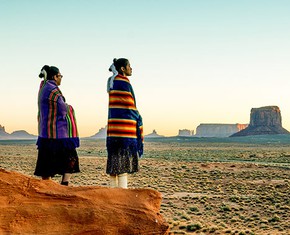The views expressed in our content reflect individual perspectives and do not represent the authoritative views of the Baha'i Faith.
Hinduism is a great religion, not so different from historically Western religions once fully understood, and the entirety of humanity has begun to recognize it as part of a single divine unfolding plan.
Hindu teachings and practices have greatly enriched the world: meditation and yoga readily come to mind, but also concepts like karma and the chakras, and the profoundly spiritual and moral teachings of Hindu scripture and poetry, especially by poets like RabrindranathTagore. There are also the contributions of world-class mathematicians and scientists who practice this religion to consider.
RELATED: How Yoga Began: The Many-Armed Dancing Shiva
Hindus are not in need of individual salvation from outside of their religion. Their religion, however, promises a renewal of civilization, and of this they—like the rest of us—are in profound need.
Hinduism has not been fully able to adequately address many of its longstanding social problems—for example, the caste system. The caste system finds scant support in Vedic literature. The sole reference in the Rig Veda is in Book (Mandala) 10, Chapter 90 where Purusa, the cosmic being who pervades everything, is metaphorically described as a person whose parts correspond to four different castes: brahmins (priests) who make up his mouth, rājanya (rulers) who make up his arms, vaiśya (skilled traders and merchants) who make up his thighs, and sūdra (unskilled workers) who make up his feet. Nothing in this, however, speaks of differential worth—all are necessary and nothing in it implies prejudice or social rigidity.
Historians still debate how the caste system arose. As the word for it in Sanskrit is varnashrama dharma and “varna” means “color,” it is often assumed that it developed as a racial designation when the lighter skinned Aryans imposed their will over the darker skinned original inhabitants of the Indian sub-continent.
However it occurred, by the time of the Bhagavad Gita, a more rigid caste system was in place—apparently as a way of preserving spiritual traditions within families. In the Bhagavad Gita (4:13), Krishna (really Vishnu) claimed to be the creator of a system in which caste was identified as reflecting people’s qualities and activities. While there is nothing particularly offensive about this, over time the idea developed that one is born into caste by virtue of karma in previous lives. At this point, being a “lower” caste member became a punitive designation, and severe prejudices developed as a result.
While the caste system may have had some positive function in past society, it is hard to see it now as anything but a system which favors some and represses others. It can be used to blame those born into dire straits, and to justify the accumulation of wealth by a chosen few. It allows the higher classes to turn their backs on the poor—a decidedly unspiritual act—and it fosters an insufferable arrogance among the elite—who are increasingly consumed with material pursuits. This hardly represents a divine system, as Baha’u’llah clearly pointed out in his tablets to the kings and rulers of the world:
Know ye that the poor are the trust of God in your midst. Watch that ye betray not His trust, that ye deal not unjustly with them and that ye walk not in the ways of the treacherous. Ye will most certainly be called upon to answer for His trust on the day when the Balance of Justice shall be set, the day when unto every one shall be rendered his due, when the doings of all men, be they rich or poor, shall be weighed.
India has one-third of the world’s poorest people, more than any other country, according to the UN’s Millennium Development Goals Report. It also has the highest number of deaths among children under five, an illiteracy rate of about 25% (worse in rural areas and especially among rural women), terrible child labor and child marriage problems, and gender discrimination that occasionally manifests as epidemics of rapes. These moral problems require a new solution—a spiritual regeneration among the entire populace.
The point is not, however, that India and Hindus have social problems; every country has social problems. The point is that India, like all countries, is in the midst of a radical social transformation in which old and religiously reinforced traditions are being challenged. This, Baha’is believe, is a direct result of the new spiritual energies released into the world by Baha’u’llah’s revelation.
RELATED: Why Religion Needs Renewal
Consider again that India, like the rest of the world, has come to the end of an age and the beginning of a new one. This description of the end-times in the Vishna Purana (4:24) may help:
Wealth and piety will decrease day by day, until the world will be totally depraved. Then property alone will confer rank; wealth will be the only source of devotion; passion will be the sole bond of union between the sexes; falsehood will be the only means of success in litigation; and women will be objects merely of sensual gratification. Earth will be venerated but for its mineral treasures; the Brahminical thread will constitute a Brahmin [rather than his character]; external types will be the only distinction of the several orders of life; dishonesty will be the universal means of subsistence; weakness will be the cause of dependence; menace and presumption will be substituted for learning; liberality will be devotion; simple ablutions will be purification; mutual assent will be marriage; fine clothes will be dignity; and water afar off will be esteemed a holy spring. Amidst all castes he who is the strongest will reign over the principality, thus vitiated by many faults. The people unable to bear the heavy burdens imposed upon them by their avaricious sovereigns, will take refuge amongst the valleys of the mountains, and will be glad to feed upon wild honey, herbs, roots, fruits, flowers, and leaves: their only covering will be the bark of trees, and they will be exposed to the cold and wind and sun and rain. No [poor] man’s life will exceed three and twenty years. Thus in the Kali age shall decay constantly proceed, until the human race approaches its annihilation.
These are those times. How do we know? In part because the Brahma Vaivarta Purana gave a clear indication of when these things would occur. It states that the Ganges would absorb the sins of people for the first 5,000 years of the age after Krishna. If Krishna lived, as many think, around 3,000 BCE and the clock on the Ganges’ work began counting then; that would bring us to today.
To many it seems obvious that the time for Indian renewal has come and is in fact occurring—but we could all progress much faster if we understood the process. This understanding, that we are in a new age, is more important to our collective future than any past system of thought—whether of the East or the West. These make good subjects to discuss with your Hindu neighbors.
















Comments
Sign in or create an account
Continue with Googleor